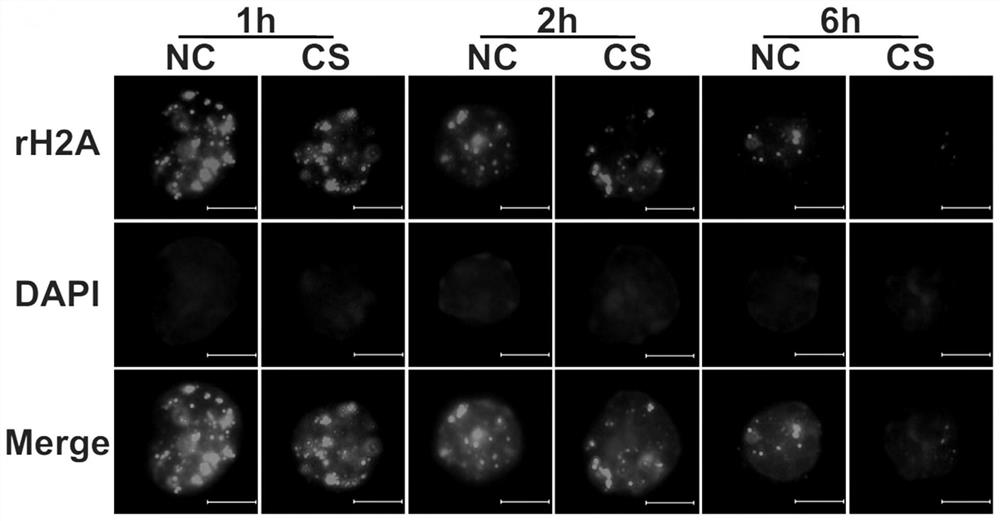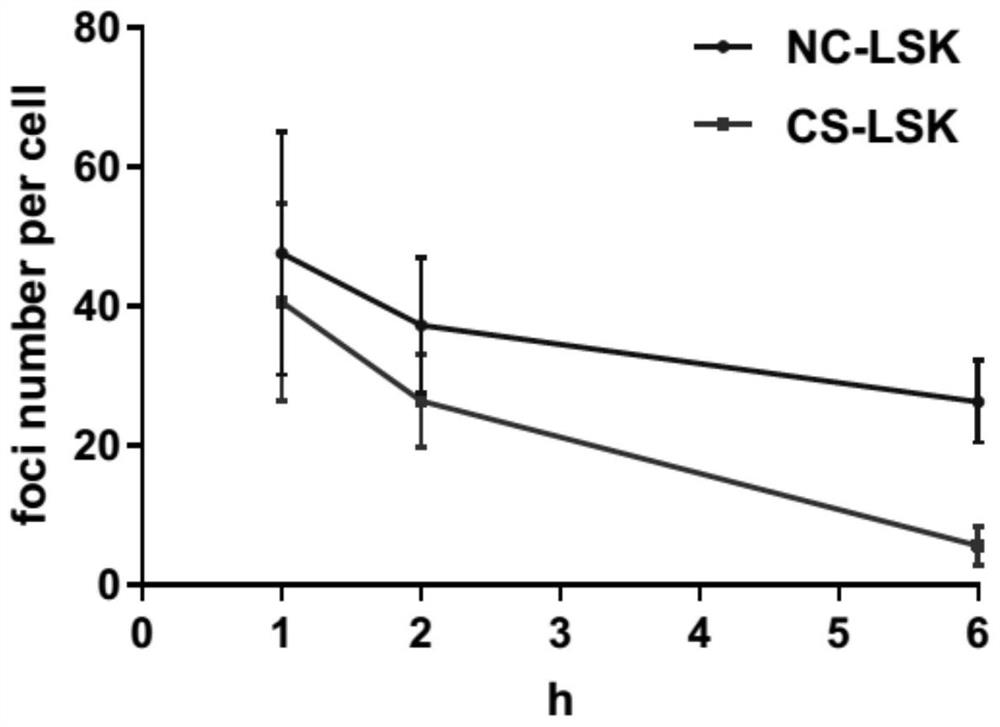Application of RORa protein and agonist thereof in preparation of acute DNA damage repairing agent
A DNA damage and agonist technology, applied in the field of biomedicine, can solve problems such as adverse reactions
- Summary
- Abstract
- Description
- Claims
- Application Information
AI Technical Summary
Problems solved by technology
Method used
Image
Examples
Embodiment 1
[0055] The cholesterol sulfate compound (Cholesteryl sulfate, CS for short) used in this scheme is specifically cholesterol sulfate sodium salt (CAS: 2864-50-8), and the molecular formula is shown in formula (I).
[0056]
[0057] (1) Preparation of CS solution: CS was dissolved in DMSO to prepare a CS stock solution with a concentration of 50 mg / ml. CS working solution is formed by diluting CS stock solution to 5 mg / ml. CS working solution was used to prepare the test agent (injection) of CS group, and its components were: CS working solution 100 μL, Tween 80 20 μL and PBS 880 μL (PBS is conventional phosphate buffered saline solution in the prior art). At the same time, the control reagent (placebo) of NC group was prepared, and its components were: 100 μL of DMSO, 20 μL of Tween 80 and 880 μL of PBS.
[0058] (2) Experimental scheme:
[0059] This program uses C57BL6 mice (8-12 weeks old) for in vivo experiments. This mouse species is the conventional experimental mous...
experiment example 1
[0065] (1) Immunofluorescence detection (γH2AX)
[0066] Following γ-ray irradiation, certain DNA damage, including DNA double-strand breaks (DSBs), occurs in mouse cells. DNA damage activates the DNA damage response (DDR). Among them, DSB formation triggers the activation of many factors, including phosphorylation of the histone variant H2AX, resulting in γH2AX. Phosphorylation of H2AX plays a key role in the DDR and is required for the assembly of DNA repair proteins at sites containing damaged chromatin and the activation of checkpoint proteins that arrest cell cycle progression. Analysis of H2AX expression can be used to detect the genotoxic effects of different toxicants, and histone H2AX phosphorylation is the most prominent marker of DNA damage. In this protocol, γH2AX is used as a relevant indicator of DNA damage by immunofluorescence technology. The immunofluorescence experimental steps are roughly as follows: 5 Cell numbers were added dropwise on glass slides and ...
experiment example 2
[0071] Experimental example 2: RORa protein knockout experiment
[0072] The conventional Cre / loxP recombinase system in the prior art is used to knock out the mouse RORa protein, and then the aging phenotype of the mouse after the RORa protein deletion is detected. Cre / loxP-based gene knockout involves first introducing loxP sequences into the genome of embryonic stem cells, and then genetically modifying or changing the target gene through Cre-mediated recombination to obtain target gene knockout mice. The experimental results showed that knocking out RORa in the blood stem cells of young mice resulted in a decrease in the DNA repair capacity of the blood stem cells of young mice. Figure 8 Fluorescence immunoassay results of γH2AX in RORa knockout mice, Figure 9 is the statistical graph of γH2AX foci, Figure 10 Graph of the fluorescence intensity of γH2AX. Figure 8-Figure 10 The experimental results showed that DNA damage in mouse HSCs was aggravated after RORa gene k...
PUM
 Login to View More
Login to View More Abstract
Description
Claims
Application Information
 Login to View More
Login to View More - R&D
- Intellectual Property
- Life Sciences
- Materials
- Tech Scout
- Unparalleled Data Quality
- Higher Quality Content
- 60% Fewer Hallucinations
Browse by: Latest US Patents, China's latest patents, Technical Efficacy Thesaurus, Application Domain, Technology Topic, Popular Technical Reports.
© 2025 PatSnap. All rights reserved.Legal|Privacy policy|Modern Slavery Act Transparency Statement|Sitemap|About US| Contact US: help@patsnap.com



